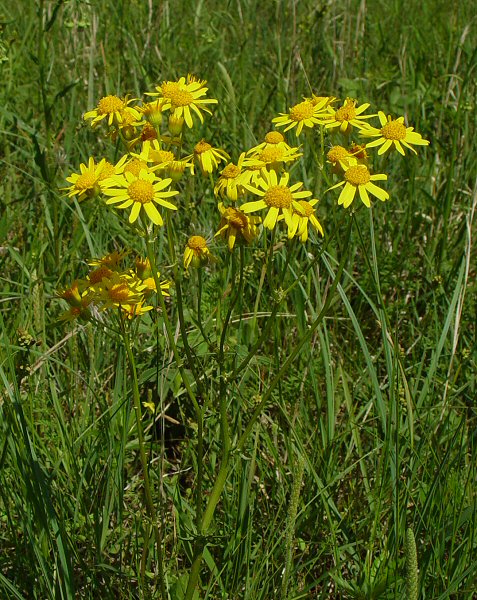Packera plattensis (Nutt.) W.A. Weber & . Lve
Prairie Ragwort

Native
CC = 6
CW = 3
MOC = 58
© DETenaglia
Packera plattensis (Nutt.) W.A. Weber & . LvePrairie Ragwort | |
 |
Native CC = 6 CW = 3 MOC = 58 |
© DETenaglia |
|
Family - Asteraceae/Senecioneae Habit - Perennial or sometimes biennial forb, from a short, usually stout, erect to horizontal rootstock, sometimes producing well-developed stolons. Stems - Erect, to 70 cm, mostly single, fistulose, more or less evenly pubescent with dense, felty hairs when young, the portion above the base sometimes becoming nearly glabrous at flowering, except sometimes for cobwebby patches in the leaf axils or at the inflorescence branch points.
Leaves - Basal and alternate. Basal leaves usually present at flowering, long-petiolate, the petioles with dense, felty hairs when young, the blades 1-9 cm long, unlobed or less commonly with few narrow, irregular lobes toward the base, ovate-elliptic to oblanceolate or rarely nearly circular, tapered to nearly truncate at the base, rounded to bluntly pointed at the tip, the margins toothed or scalloped, the surfaces evenly and more or less persistently pubescent with dense, felty hairs when young, usually becoming nearly glabrous by flowering time, except toward the base of the petiole. Stem leaves gradually reduced toward the stem tip, sessile or nearly so, the blades entire or more commonly irregularly and usually deeply pinnately lobed, the terminal lobe ovate to elliptic-obovate, longer than wide, the margins otherwise relatively sharply toothed, the surfaces evenly and more or less persistently pubescent with dense, felty hairs when young, usually becoming nearly glabrous by flowering time.
Inflorescence - Numerous flower heads in a terminal corymbiform cyme. Branches of inflorescence with cobwebby pubescence in axils. Peduncles with minute linear bracts often subtending flower heads.
Heads - Involucre 4-7 mm long, glabrous or somewhat cobwebby-hairy at least near the base. Phyllaries in a single series, connate for most of their length, with scarious acuminate tips. Receptacle flat.
Florets - Ray florets fertile, usually 7-9, the lobe 5-10 mm long, orangish-yellow. Pappus of barbed capillary bristles to 5 mm long. Disk to 8 mm in diameter. Disk florets fertile, the corollas orange-yellow, 5-lobed.
Fruits - Achenes 2.5-3.0 mm long, brown, usually hairy along the ribs, occasionally glabrous or the surface evenly hairy. Flowering - April - June. Habitat - Upland and loess hill prairies, glades, ledges and tops of bluffs, upland forest openings, pastures, railroads, roadsides, and open, disturbed areas. Origin - Native to the U.S. Lookalikes - Other species of Packera, especially P. paupercula. Other info. - This species can be found scattered throughout Missouri as well as most of the central third of the continental U.S. It may be difficult to distinguish from some other species of Packera, and in some cases may be virtually indistinguishable from P. paupercula. The cobwebby pubescence on many parts of the plant is a good clue, but this is highly variable among different populations and also the age of the plants. Key differences in pubescence as described by different authors can be confusing, contradictory, and/or controversial. Different species of Packera can also cross, further muddying the situation. Further study of the complex is needed. Photographs taken off Hwy U in Benton County, MO., 5-15-04 (DETenaglia); also at St. Joe State Park, St. Francois County, MO, 4-28-2014, and Washington State Park, Washington County, MO, 4-18-2016 and 4-16-2019 (SRTurner). |